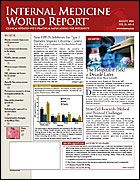Publication
Article
Internal Medicine World Report
Diagnosis of Type 2 Diabetes Cannot Rely on Specific Symptoms
Author(s):
From the American Diabetes Association
Nathaniel G. Clark, MD
WASHINGTON, DC?Approximately two thirds of patients with type 2 diabetes have none or only 1 of the 7 classic symptoms of the disease, according to new data reported at the 66th Scientific Sessions of the American Diabetes Association (ADA), suggesting that physicians should not rely on the presence of 1 or multiple symptoms when considering testing for diabetes.
The ADA has recommended that individuals consult their physician if they have ≥1 of the following symptoms that may indicate diabetes:
? Unusual weight loss
? Extreme hunger
? Irritability
? Blurry vision
? Excessive thirst
? Increased fatigue
? Frequent urination.
"Our results may mean that the majority of diagnosed diabetes patients have few symptoms or that the symptom list is not good at distinguishing people who have diabetes from those who do not," Nathaniel G. Clark, MD, vice president of the ADA in Alexandria, Va, commented.
He and his colleagues studied the frequency of ADA symptoms being reported by those who already have diabetes or who are at high risk for it.
"Although symptoms have been validated in diabetic patients, it is not known how specific they are, either singly or in groups, for the initial diagnosis of diabetes," said Dr Clark. "Identifying the symptoms or other patient characteristics that are highly associated with a diagnosis of type 2 diabetes is valuable in achieving our goal of early diagnosis and treatment."
For this analysis, data were culled from the Study to Help Improve Early Evaluation and Management of Risk Factors Leading to Diabetes (SHIELD), a 5-year, longitudinal study of risk factors for diabetes, cardiovascular (CV) disease, and metabolic syndrome among adult Americans.
A comprehensive questionnaire was sent to 22,001 persons with self-reported diabetes or risk factors for type 2 diabetes, such as abdominal obesity, high body mass index, hypertension, dyslipidemia, and a history of CV events.
Some 44% of respondents with type 2 diabetes reported having no symptoms within the past 12 months, and 22% said they had only 1 symptom.
A total of 56% of respondents with type 2 diabetes had ≥1 ADA symptoms compared with 46% of those with 3 to 5 risk factors (high risk) and 31% of those with zero to 2 risk factors (low risk).
The most often cited symptoms in all groups were frequent urination (33.9%, 24.2%, and 13.2%, respectively) and increased fatigue (27.4%, 23.2%, and 14.4%).
Respondents who reported excessive thirst were 2.5 times more likely to have been diagnosed with type 2 diabetes. "This finding suggests that patients and their physicians are more sensitive to this symptom," Dr Clark noted. Nevertheless, only one fifth of patients with type 2 diabetes reported excessive thirst, suggesting that people with other common symptoms of diabetes, such as frequent urination or fatigue, may not be appropriately targeted for testing.
This study demonstrates that the occurrence of ≥1 diabetes symptom alone is not specific enough to adequately identify persons who should be evaluated for type 2 diabetes, because, according to Dr Clark, these symptoms may not be prevalent enough among those with diabetes to "drive" testing.





